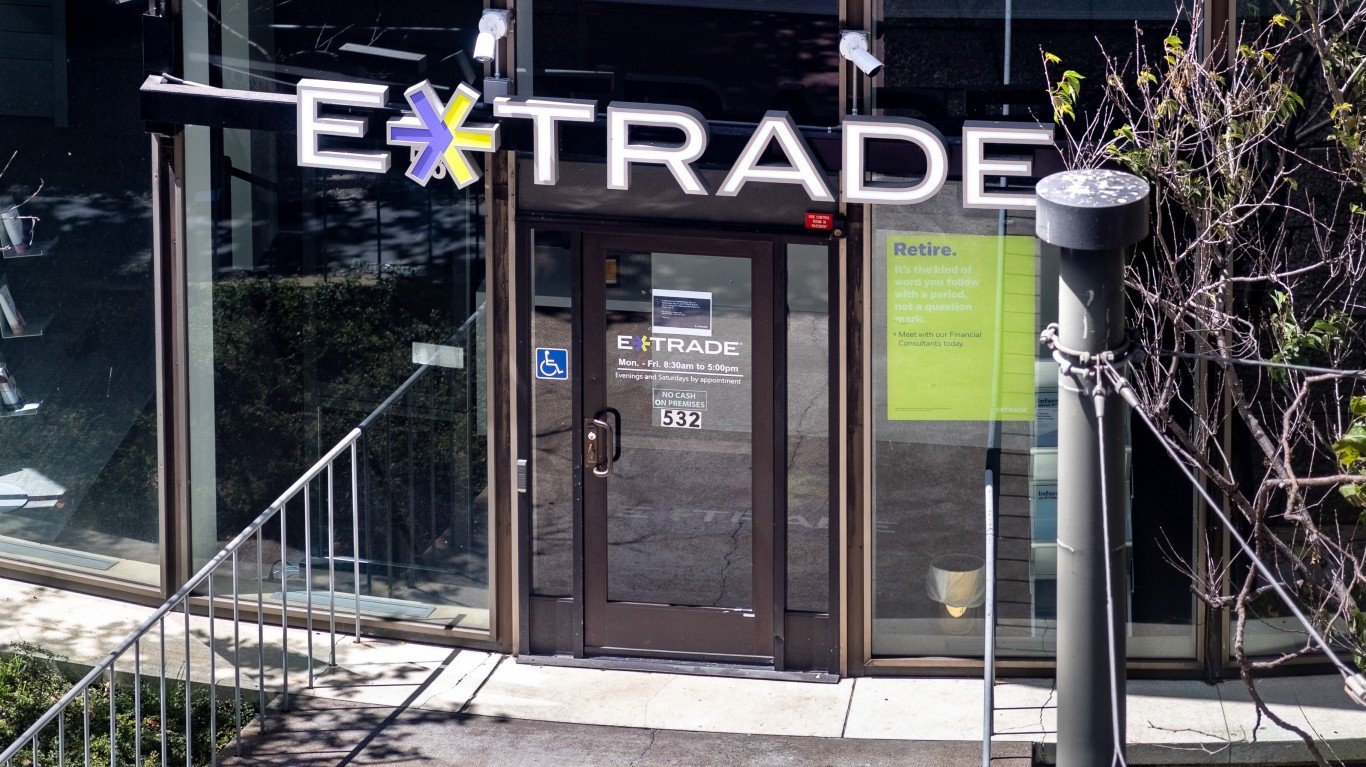

At the start of every year, 24/7 Wall St. issues its views on how the consensus price targets for major stocks in the Dow Jones industrial average and S&P 500 can influence the direction of the stock market that year. There is no secret or major insight in reminding investors and traders that the end of 2018 was extremely volatile and sloppy. It was the worst December for the Dow going all the way back to the Great Depression.
Sometimes analyst forecasting can be quite spot on. Other times, not so much. When 24/7 Wall St. evaluated the 30 Dow components based on their consensus price targets, the result was that the end of 2019, or its peak, would be a Dow 28,000.
Make no mistake: that seemed like a fairy tale target when we compiled all the data on December 31 and January 1. It feels like even more of a fairy tale now that Apple Inc. (NASDAQ: AAPL) dropped a very rare bombshell of a revenue warning for its quarterly sales.
There are many broad sectors that need to be considered for 2019. One of those is undoubtedly the financial sector. After all, throughout history it has been hard for the stock market as a whole to rise if the major banks and financials perform poorly. While this may sound gloomy, it does not assure that the finance stocks will have repeat performances of 2018 in 2019.
Another “no secret” issue is that the major financials performed quite poorly in 2018. And December was not kind there either. What may not be as well known now is that Wall Street just isn’t being fair to the public when it evaluates its own prospects for 2019.
The end result is not going to be fun for some investors. Analysts have to dial down their price targets and expectations for the major financial stocks during January. If thinking that the Dow could rise 20% to 28,000 seems fishy, how realistic does it sound that major banks should have target prices that imply total returns of 20%, 30% or even 50% in 2019?
Before thinking this is a total wipeout for financials in 2019, note that the outcome is not a foregone conclusion. There is a whole year ahead that things can change. And bank stocks could outperform as value investors look for safe earnings and low price-to-earnings and book value metrics. The point here is that Wall Street analysts need to get real about how they value the market’s prospects and their own prospects as a whole during January. The sooner the better.
We have included our year-end reviews for the financials in the Dow first as they were published heading into 2019. An update in the price performance has also been offered there. After those, we have shown a chart and given some basic data on the other major bank and financial stock outlooks for 2019.
American Express: What Will Credit Card Metrics Do in 2019?
American Express Co. (NYSE: AXP) closed out 2018 at $95.32 a share, down 4% from a year earlier. One issue that may have kept pressure on in 2018, outside of the overall plunge in financial stocks, was that Amex shares had gained a surprising 34% in 2017. Gains of that size tend to rob future gains. Amex has a consensus target price of $114.94, with an implied gain of about 20% ahead, or 22% if you include its 1.6% dividend yield.
Warren Buffett and Berkshire Hathaway continue to remain the anchor shareholder for American Express. The company needs to make certain its clients do not see eroding credit metrics with delinquencies and charge-offs in 2019. Oddly enough, the consensus target price is less than 0.4% above Amex’s 52-week high.
Amex shares were trading down another $0.90 at $94.38 midday Thursday, down from the $95.32 year-end price in less than two full trading days. A gain of 20% would mean that Amex would return to its 52-week high, and that would be a gain of more than 100% from its five-year low seen when its woes were present in 2016.
Goldman Sachs: Can the “Golden Slacks” Image Return After an Awful 2018?
Goldman Sachs Group Inc. (NYSE: GS) has found itself in the midst of international scandal and domestic investigations again, and new CEO David Solomon just doesn’t really seem to want to communicate to the public and investors as much as Lloyd Blankfein did. After a small gain of 6.4% in 2017, Goldman Sachs lost about 34% of its value in 2018. It is supposed to be the top investment bank for the wealthy and institutions, but the firm wants its Marcus online bank and finance play to move to the masses and younger clients.
After closing at $167.05 in 2018, Goldman Sachs shares have a 52-week range of $151.70 to $275.31, and the consensus analyst estimate was still somehow all the way up at $253.30 as 2018 ended. That would imply upside of 51.6% before considering its 1.9% dividend yield. The consensus price target had been up at almost $275 at the start of November, but this seems like yet another situation in which analysts did not lower expectations enough and will need to greatly dial down their price targets and expectations as 2019 gets underway. Goldman Sachs historically traded at a premium to its book value, but it was down at about 0.8 times book value at the end of 2018.
Goldman Sachs may be a great investment bank for the wealthy and for institutions, but expecting a gain of 50% in a single year, with its investigations and international woes being prominent, would imply that everything would have to run super-smoothly ahead at a time when volatility rules.
JPMorgan: Deregulation Booster Turned South
JPMorgan Chase & Co. (NYSE: JPM) blew out expectations in 2017, with shares returning almost 24%, when analysts were originally expecting a −1.1% return. But Jamie Dimon and his team’s share price dropped by 8.7% in 2018.
Shares of JPMorgan closed 2018 at $97.62 apiece. The year-end consensus price target of $120.07 was far higher than the consensus target of $104.23 from a year earlier. And the 3.3% juiced-up dividend yield would imply a total return of 26.3%, if the pool of analysts is proven to be correct.
JPMorgan shares were trading down less than 1% at $97.88 on Thursday. That’s basically flat versus the 2018 close, but a gain up to $120 and change means the bank would have to put in a new all-time high when the economy is slowing and when the yield curve is in a Fed-induced coma.
Travelers: Still the Forgotten Dow Stock
Travelers Companies Inc. (NYSE: TRV) is one that most investors probably never really think of as a Dow stock. It lost 11.7% in 2018, after a gain of 10.8% in 2017. Analysts were only looking for a return of about 2% in 2018, and the weakness in anything tied to the financial sector weighed on the shoulders of Travelers. Investors have to hope a flattening or an inverted yield curve won’t harm insurance companies as much as it could harm the banks.
The insurance and financial giant closed 2018 at $119.75 a share, down from a 52-week high of $150.55. The year-ahead consensus target price of $136.06 was very similar to last year’s target of $135.31. If analysts are correct, the 2.6% yield would help investors get a return of better than 16% in 2019.
This return opportunity of 16% may not seem crazy like some of the others, but with shares down at $116.20 on Thursday, it was already down about $4 per share in less than two full trading days.
Visa: Still Riding Credit Card Transaction Game
Visa Inc. (NYSE: V) doesn’t necessarily care what kind of transaction you make using its credit card because it gets a piece of the action on transaction fees. It just wants more shoppers and buyers using Visa. After a 46% return in 2018 was more than double the expectations in 2017, Visa’s 15.7% price gain in 2018 compared with a total return expectation a year earlier of 9.8%.
At $131.94 in a 52-week range of $111.02 to $151.56, its shares had a year-end consensus target price of $163.56. That would have implied a potential gain of 23.9% for 2019. Visa could stand to do some work on its dividend yield, as it is the weakest of the 30 Dow stocks at just 0.7%.
Visa is one of those financial stocks that has been hard to evaluate. It’s not a bank and doesn’t take risk. It just wants the transaction fees and makes the actual credit card issuers take the transaction risk and worry about whether consumers pay their credit cards timely.
Other Financial Stocks
The other financial stocks took it on the chin as well in 2018. Their expected “total return” upside also seems ridiculous when you look at the table below.
Bank of America Corp. (NYSE: BAC) lost about 16% in 2018 but was down about 25% from its 52-week high. Even with a better 2.5% dividend yield, how likely does it seem at the start of 2019 that investors should expect close to a 40% gain to new decade highs? It does at least have Merrill Lynch that can keep growing assets, but any further market losses will only erode away at their money management fees and asset base.
Capital One Financial Corp. (NYSE: COF) may be a leader in independent credit card issuers, but it lost 24% in 2018 and was estimated to have an implied total return of 50% to new highs in 2019. How realistic does that sound at a time when credit standards should face some tightening and when consumers may start to slow their spending?
Citigroup Inc. (NYSE: C) has often been touted the bank with the most upside, as it traded below book value when all other money-center banks traded above book value. But things don’t seem to be the same in 2019. After losing 30% in 2018, does a return to a decade high and a 60% total return upside seem likely at this stage of the game?
Wells Fargo & Co. (NYSE: WFC) went from the king of banks to the “poster child of naughty” after its account-opening and customer handling scandals. Wells Fargo has even seen Warren Buffett and Berkshire Hathaway trim their massive stake in recent quarters. After the stock lost 24% in 2018, Wall Street’s implied upside would be over 36% in 2019, if you include its dividend yield. The one thing that makes this look less ridiculous at the current time is that Wells Fargo’s 52-week high would still be about 10% above the year-end consensus price target.
Morgan Stanley (NYSE: MS) often trades more or less in-line with Goldman Sachs. That said, its loss in 2018 was “only 24%,” versus a 34% loss for Goldman. With a year-end price of $39.65, at least the consensus target price of $56.22 was still under its 52-week high of $59.38. Still, it is hard to think a 44% implied total return seems realistic in this current climate.
| BAC | COF | C | WFC | MS | |
|---|---|---|---|---|---|
| 2018 Close | $24.64 | $75.59 | $52.06 | $46.08 | $39.65 |
| 2018 Gain/Loss | -16.50% | -24.10% | -30.00% | -24.00% | -24.40% |
| 52-Week Range | $22.66 – $33.05 | $69.90 – $106.50 | $48.42 – $80.70 | $43.02 – $66.31 | $36.74 – $59.38 |
| 2019 Target | $33.87 | $112.19 | $81.88 | $61.26 | $56.22 |
| Est. Upside | 37.46% | 48.42% | 57.28% | 32.94% | 41.79% |
| Yield | 2.50% | 2.10% | 3.50% | 3.80% | 3.00% |
| Tot. Return Est. | 39.96% | 50.52% | 60.78% | 36.74% | 44.79% |
As we noted in our 2019 Bull/Bear Outlook, it seems very likely that analysts will be lowering their price targets in January and early in 2019. This needs to happen in many sectors, and the financial sector needs price targets cuts just as much as other leading sectors. This does not mean at all that bank and finance stocks cannot rise in 2019. They very well could rise, particularly if Jerome Powell and the Federal Reserve finally realize that they can stop raising interest rates. It’s not normal to see consensus upside projections of over 20% for the market as a whole this late in the business cycle, but looking for routine upside of 30% to 50% in the major banks and financial stocks seems even more unreasonable.
Take This Retirement Quiz To Get Matched With An Advisor Now (Sponsored)
Are you ready for retirement? Planning for retirement can be overwhelming, that’s why it could be a good idea to speak to a fiduciary financial advisor about your goals today.
Start by taking this retirement quiz right here from SmartAsset that will match you with up to 3 financial advisors that serve your area and beyond in 5 minutes. Smart Asset is now matching over 50,000 people a month.
Click here now to get started.
Thank you for reading! Have some feedback for us?
Contact the 24/7 Wall St. editorial team.
 24/7 Wall St.
24/7 Wall St.


